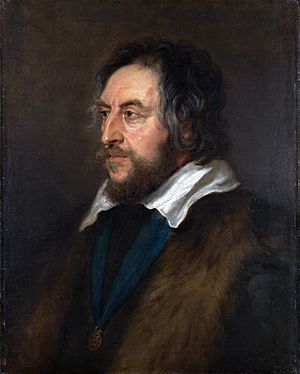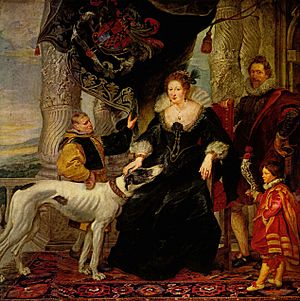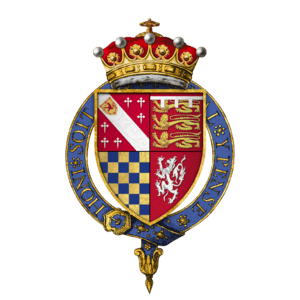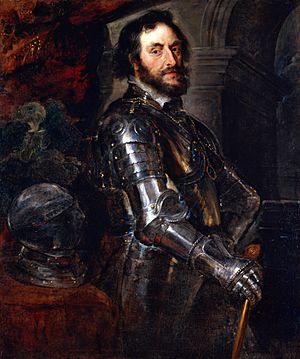Thomas Howard, 14th Earl of Arundel facts for kids
Quick facts for kids
The Earl of Arundel
|
|
|---|---|

Portrait by Peter Paul Rubens
|
|
| Born | 7 July 1585 |
| Died | 4 October 1646 (aged 60) Padua, Italy
|
| Burial place | Fitzalan Chapel, Arundel |
| Spouse(s) | Alethea Talbot |
| Parent(s) | Philip Howard, 13th Earl of Arundel Anne Dacre |
Thomas Howard, the 14th Earl of Arundel (born July 7, 1585 – died October 4, 1646), was an important English nobleman. He worked as a diplomat and helped King James I and King Charles I. However, he became most famous for being a great traveler and an amazing art collector.
When he passed away, he owned 700 paintings. He also had huge collections of sculptures, books, prints, drawings, and old jewelry. Many of his marble statues, known as the Arundel marbles, were later given to the University of Oxford. People sometimes called him "the Collector Earl" because of his passion for art.
Contents
Becoming the Earl of Arundel
Thomas Howard was born in 1585 in Finchingfield, Essex. His family, the Howards, were very important nobles. However, they had lost favor with Queen Elizabeth I. This was partly because they were Catholic and some family members were involved in plots against the Queen.
Thomas never knew his father, Philip Howard, 13th Earl of Arundel. His father was put in prison before Thomas was born. Because of this, Thomas did not inherit his father's title right away. He was first known as Lord Maltravers.

When King James I became king in 1603, Thomas's great-uncle, Henry Howard, Earl of Northampton, helped him. Thomas regained his family titles and some of their lands in 1604. The next year, he married Lady Alethea Talbot. She was the daughter of Gilbert Talbot, 7th Earl of Shrewsbury.
Alethea inherited a very large estate, including lands in Nottinghamshire, Yorkshire, and Derbyshire. This included the town of Sheffield. This inheritance became a major part of the family's wealth. Even with this large income, Thomas's love for collecting art and building things often put him in debt.
Thomas Howard's Public Life
Thomas Howard was a skilled diplomat during the time of King James I. After joining the royal court, he traveled abroad. These trips helped him develop his strong interest in art.
In 1611, he was made a Knight of the Garter. This is a very special honor. In 1613, he traveled with Elizabeth, the Electress Palatine, to Heidelberg for her wedding. He also visited Italy again during this trip.
On Christmas Day in 1615, he joined the Church of England. He then took on official roles, becoming a Privy Councillor in 1616. He supported Sir Walter Raleigh's trip to Guiana in 1617. He also became part of the New England Plantations Committee in 1620.
In 1621, he was briefly sent to the Tower of London. This happened because he insulted another nobleman, Baron Spencer. He also upset Prince Charles and the Duke of Buckingham. This was because he did not want a war with Spain in 1624.
His son Henry married Lady Elizabeth Stewart without the king's permission. Because of this, King Charles I put Thomas in the Tower of London. He was later released in 1626. In 1628, he was freed again by the Lords. He then became a privy councillor once more.
In 1621, Thomas was made Earl Marshal. This was an important position in charge of ceremonies and noble families. In 1632, he went to The Hague to offer condolences to the king's sister, Elizabeth Stuart. In 1634, he traveled with King Charles to Scotland for his coronation.
In 1636, Thomas went on a mission to Emperor Ferdinand II. He tried to get the Palatinate back for Charles I's nephew, Charles Louis. This mission was not successful. In 1638, he was put in charge of forts near the Scottish border. He was also made general of the king's forces in the first Bishops' War.
In 1641, he was the Lord Steward of the royal household. He also oversaw the trial of the Earl of Strafford. This marked the end of his public career. He became distant from the court again. In 1642, he traveled with Princess Mary for her marriage.
Later Life and Legacy
As the Civil War was starting, Thomas decided not to return to England. He settled first in Antwerp and then in a villa near Padua, Italy. He gave £34,000 to the king's cause. He also lost a lot of money during the war.
He died in Padua in 1646. He had returned to the Roman Catholic faith before his death. He was buried in Arundel. His eldest son, Henry Howard, 15th Earl of Arundel, became the next Earl. Henry was an ancestor of the Dukes of Norfolk. His youngest son, William Howard, 1st Viscount Stafford, was an ancestor of the Barons Stafford.
Thomas had asked the king to restore the family's old title of Duke of Norfolk. This did not happen until his grandson's time. However, he was made Earl of Norfolk in 1644. This made sure the title would stay in his family.
A Great Art Collector
Thomas's trips as a special envoy to Europe's great courts made him even more interested in collecting art. He became known as a major supporter and collector of artworks. People like Walpole called him "the father of virtu in England." He was also part of a group of art lovers connected to King Charles I.
He asked famous artists like Daniel Mytens, Peter Paul Rubens, Jan Lievens, and Anthony van Dyck to paint portraits of him or his family. He also bought paintings by Hans Holbein, Adam Elsheimer, and Honthorst.
Among Thomas's friends were scholars and writers like James Ussher, William Harvey, and Francis Bacon. The famous architect Inigo Jones went with Thomas on a trip to Italy in 1613 and 1614. They traveled as far as Naples. In Italy, Thomas saw the work of Palladio. This work later greatly influenced Inigo Jones's career.
Thomas collected drawings by Leonardo da Vinci, the two Holbeins, Raphael, and Dürer. Many of these drawings are now at the Royal Library at Windsor Castle or at Chatsworth.
He had a huge collection of ancient sculptures, mostly Roman. Some he even dug up himself in Greece. This was the most important collection of its kind in England at the time. His collection also included fragments, pictures, gems, coins, books, and old manuscripts. These were kept at Arundel House.
Sadly, much of his collection was damaged during the Civil War. Nearly half of the marble statues were destroyed. After his death, the remaining treasures were spread out. The marble and statue collection was later given to Oxford University. It is now in the Ashmolean Museum.
In 1995, the J. Paul Getty Museum held an exhibition. It showed Thomas Howard's and his wife Alethea's amazing art collection.
Manuscript Collections
Thomas's important collection of manuscripts went to his son, the 15th Earl, after his death. Later, they went to his grandson, Henry Howard. In 1666, Henry divided the collection. Some went to the Royal Society and some to the College of Arms.
The Royal Society sold its part to the British Museum in 1831. These are now known as the Arundel Manuscripts in the British Library.
Family Life
Thomas and his wife Alethea married in 1606. They had six children together:
- James Howard, Lord Maltravers (1607–1624)
- Henry Howard, 15th Earl of Arundel (1608–1652)
- William Howard, 1st Viscount Stafford (1614–1680)
- Mary Anne Howard (1614-1658)



